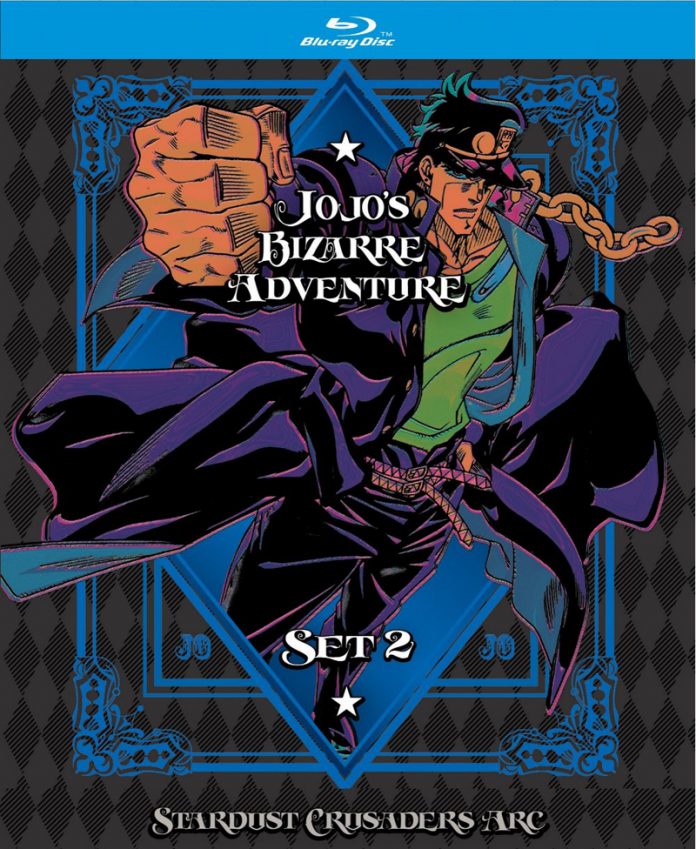JoJo fans should view VIZ Media as their saviors. Thanks to their efforts they were able to rescue the JoJo’s Bizarre Adventure franchise! Now that it has been airing on Toonami, JoJo has lost its cult classic label and turned into one of the more popular properties in anime. It’s Stardust Crusaders (Part Three) that is given credit for bringing the most attention to the franchise. It’s the series that everyone seems to know. I have been tasked with reviewing not only the series but the home media release, which feels daunting. So how does it look compared to other releases, and does it match the legendary status that the series has garnered on Toonami?
Our story focuses on Jotaro Kujo, who is the grandson of Battle Tendency’s protagonist Joseph Joestar. It is Joseph who travels to Japan to help Jotaro better understand the strange power that Jotaro possesses. Jotaro is convinced that an evil spirit is following him and locks himself up in a jail cell to keep others safe. Joseph (and his companion Avdol) explains Jotaro’s power, which is called a Stand. It’s a manifestation of a person’s soul used to fight. Joseph tells Jotaro that an old rival of his grandfather, Dio Brando, is to blame for the recent emergence of stands. Before he died, DIO combined his head with Jonathan Joseph’s body and the stand powers of Jonathan’s descendants have activated. Joseph wants to stop DIO, but Jotaro declines because he isn’t interested. Jotaro’s mother, Holy, later falls ill when her stand is enabled by DIO’s influence. To save Holy, Jotaro and his gang (Joseph, Avdol, Kakyoin, and Polnareff) must travel to Egpyt to save her.
Isn't that how long Holy was sick for in Stardust Crusaders? #Toonami
— VIZ (@VIZMedia) August 19, 2018
I was shocked at what an easy watch Stardust Crusaders is. Most of this release has story arcs that last one or two episodes. Unlike other shōnen series, Stardust Crusaders first 24 episodes didn’t feel like a grind. Each villain shows up to try and stop our heroes, and get taken care of in one shot (or two, depending on the individual arc). Fans are treated to crazy situations that are resolved in a short amount of time, which upped the entertainment value. Stardust Crusaders continues to hold onto its bizarre momentum, meaning there are fewer lulls than you’d normally see. In a longer series, making the grind of watching more enjoyable can be difficult. However, Stardust Crusaders was such a fun ride it made it hard to stop watching.
The aesthetics of a series is essential for peak enjoyment, and Stardust Crusaders has that in spades. I love the character designs for the main cast and believe that most fans will feel the same. They are all larger than life and look amazing when they fight with their stands. Just looking at Jotaro himself should be enough to make fans love this series. JoJo has always had fantastic character designs, and I feel that Stardust Crusaders has the best. But it isn’t just the character design that draws fans to this series. The animation during the fights looked great, too. Even if the action can get a bit brutal (so much so that it might catch you off guard), it looked just as I’d expect from a JoJo show. David Productions does a beautiful job of animating such a wacky anime. The studio didn’t make the anime look different from its source, because if that were the case, fans would revolt.
Stardust Crusaders – Weekly Jump, July 8, 1991 pic.twitter.com/yO1nr1LWeB
— JoJo Art Archive (@ArakiArchive) July 29, 2018
I give credit to the scripts that were both funny and historically accurate for the time (1987). JoJo series has a knack for the amount of talking that’s done. Characters have a habit of over-explaining things, which also occurs in Stardust Crusaders. Those new to the franchise might find it odd or even annoying, but those who have already experienced JoJo will feel right at home. I’m glad that the dialogue stayed authentic to the time. It was funny to hear the references (such as hearing about the beauty of Audrey Hepburn for example). I usually don’t focus as much on scripts, but the pop culture references were a nice touch.
As for characters, I was pleasantly surprised to see the growth Polnareff experienced during the 24 episodes. His reason for joining Jotaro’s group was so he could find a man with two right hands who is responsible for murdering his sister (instead of wanting to stop DIO). It might be a tad cliche, but watching Polnareff deal with the demons that the murderer left him was something else. It gave more dimension to a character who was used mainly for comic relief. I wish Polnareff didn’t meet up with the murderer, Centerfold, so soon (or J. Geil, for those who are familiar with the non-localized names). I was hoping that the search for Centerfold would linger on and give Polnareff a reason to stay with the group. Still, despite it happening so soon, the battle between Polnareff and Centerfold was one of the better story arcs that unfolded. It leads to some high stakes, with Avdol “dying,” and allowed Polnareff to become a more patient man when dealing with adversaries.
After that fight, I thought we’d get more of Polnareff’s typical comic relief. But he had ANOTHER deep story arc when he had to face the wish-granting stand Judgement. Polnareff wishes that both Avdol and his sister Sherry will come back to life, thinking that everything would be fixed. Instead, Judgement creates fakes of Polnareff’s loved ones, and they try to kill him. Polnareff comes to terms with what happened in his past and accepts that bringing people back from the dead wouldn’t honor their sacrifice or memory. Once he found out they were fake, he ended up killing them, which couldn’t have been easy. Thankfully, he became much stronger as a person in the long run and his bravery was rewarded with Avdol returning to the group.
#ToonamiTrivia: One year ago today, the English Dub of #JoJosBizarreAdventure Stardust Crusaders premiered on Toonami after a successful run of Parts 1 and 2. Only 2 episodes of Part 3 remain before we start Part 4. pic.twitter.com/TlN9GzAp8e
— Toonami Faithful (@ToonamiNews) July 29, 2018
As much as I love JoJo, there always something in each part that makes me feel uncomfortable. One of those things in JoJo’s Bizarre Adventure is cruelty to animals. It always leaves a bad taste in my mouth because of how gruesome and violent it is. Seeing an animal die as collateral damage disturbed me. I wouldn’t want to see them get killed the way that they did. One terrible moment was when Rubber Soul used his stand Yellow Temperance to kill a young boy’s dog right in front of him as he was battling Jotaro. Hearing how upset the family was watching their dog die hurt my heart. It was gross, and sadly, examples of that are littered throughout Stardust Crusaders.
Then we have episode seven, which made me wonder why anything like this was needed. We watch an Orangutan sexually harass an 11-year-old girl. Let that sink in for a second. Despite the obvious moral issues, there was no need to have Anne involved in the series whatsoever. She added a damsel in distress trope to Stardust Crusaders which felt entirely out of place. If Anne were a main character and joined the group throughout the entire series, then I’d at least understand why she entered the story. However, her impact in this series was non-existent, and was added to create some unnecessary drama. Having to watch as the ape peeped on Anne and seeing her body is something I don’t think anyone needed. Stardust Crusaders offer great action sequences, funny one-liners, and amazing aesthetics, so something like this was not necessary.
The dubbing of Stardust Crusaders had to of been a fun process because the cast sounded like they were enjoying what they had to say. The entire cast did a great job bringing everyone to life. After Hunter x Hunter, I think this is one of the best English dubs around. I loved the outbursts from Richard Epcar as Joseph. He continued to make me laugh again and again with his “oh my god” lines or the expletives he uttered when he was being attacked. Doug Erholtz also did a great job bringing the energy to Polnareff. Erholtz probably was given the hardest character to voice (with how “hammy” Polnareff is), and I commend the job he did. The rest of the cast (Matt Mercer, Kyle Hebert, and Chris Tergliafera) also did a fantastic job portraying Jotaro, Kakyoin, and Avdol respectively. But just as the main cast was memorable, even those with bit parts in Stardust Crusaders left a positive impression. Barbara Goodson did an excellent job playing Enyaba, (she had to scream a lot), and I loved Imari Williams as Hol Horse. The list goes on, with others such as Ray Chase, Karen Strassman, and Tara Sands playing some outrageous characters that allowed them to get wild in the booth.
VIZ Media gave Stardust Crusaders a similar release to their previous JoJo offering. It came in a fantastic looking box with some great art showing Jotaro and his stand Star Platinum. It came with a key animation booklet and art cards for those who enjoy getting physical extras. VIZ Media also stacked six cast interviews in the release, with Matt Mercer, Doug Erholtz, Richard Epcar, Chris Tergliafera, Ben Diskin, and Patrick Seitz. Three art galleries are also included, providing a ton of JoJo content.
I liked Stardust Crusaders, as it was my favorite story arc (before Diamond is Unbreakable came out). However, it’s hard for me to recommend this release to people who aren’t already immersed in the JoJo fandom. I began my journey into JoJo through this series (before the first two parts), but because I fit the demographic that JoJo appeals to I think I look at this series more favorable than others might. The violence in this series featuring both humans and animals can be something that might lead others to shy away. Some might find it amazing and actually enjoy the gorier entertainment. It already has a well-established fan base, so I don’t think much of what I say will change anyone’s mind about giving it a try. This was made for the fans, and knowing JoJo fans, I’m sure they’ll be pleased with what VIZ Media provided.
Rating: 8/10
Pros: The English cast had many memorable moments; David Productions animation; great scripts; the opening for the first 24 episodes; the home media release box.
Cons: A lot of cruelty toward animals; action can be a bit more brutal than some would like; episode seven.
C.J Maffris is an editorial writer for toonamifaithful.com. Feel free to follow C.J on Twitter @SeaJayMaffris


